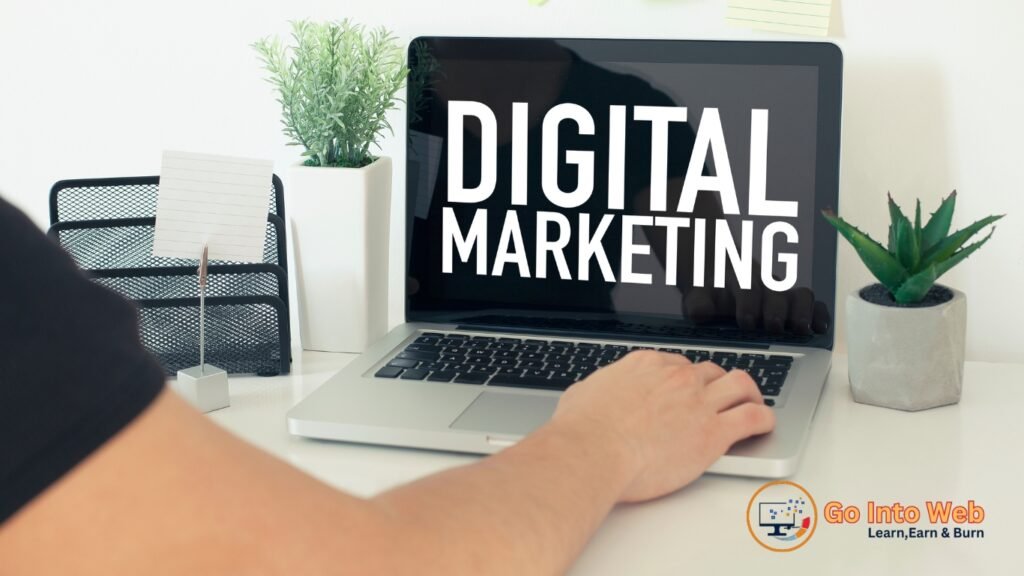Digital marketing is the use of digital channels and technologies to promote products, services, and brands. It involves creating and sharing content, such as ads, social media posts, and emails, to reach and engage with an audience. Digital marketing aims to reach a wide and diverse audience, track and measure results in real-time, and drive conversions. It encompasses a range of tactics, including search engine optimization (SEO), social media marketing, email marketing, and content marketing.
For example, a company may use digital marketing to promote its new line of athletic shoes. It may create a website and optimize it for search engines, so that when people search for “athletic shoes,” the company’s website appears high in the search results. The company may also create social media accounts on platforms like Facebook and Instagram and use them to share updates about its products and engage with its followers. Additionally, the company may use email marketing to send newsletters with special offers and product recommendations to people who have signed up to receive them. By using a combination of these tactics, the company can reach a large and diverse audience and drive conversions.
Why Digital Marketing is so important?
Digital marketing is an essential part of modern business, with companies of all sizes and industries utilizing it to reach and engage with their target audience, track and measure results, and drive conversions.

One of the main advantages of digital marketing is its ability to reach a wide and diverse audience. With billions of people active on the internet and social media, businesses can use digital marketing to reach a large and diverse audience, regardless of their location or demographics. This includes people of all ages, genders, and locations, making it a highly effective way to reach a large and diverse audience.
Another advantage of digital marketing is its ability to track and measure results in real-time. With tools like Google Analytics, businesses can see how many people are visiting their website, where they are coming from, and what actions they are taking. This allows businesses to optimize their campaigns and allocate resources more effectively.
The ultimate goal of digital marketing is to drive conversions, whether that means getting people to make a purchase, sign up for a newsletter, or download an app. By creating targeted and personalized marketing campaigns, businesses can increase the chances of getting their audience to take action. Digital marketing allows businesses to target their ads to specific audiences and pay only for the clicks or impressions they receive, making it a cost-effective way to drive conversions.
Digital marketing also allows businesses to personalize their marketing efforts to deliver targeted and personalized experiences to their customers. According to a survey by Epsilon, personalized emails have an open rate of 29% higher than non-personalized emails.
Digital marketing can improve the customer experience by providing personalized and relevant content, as well as making it easier for customers to find and engage with a business. According to a survey by Salesforce, businesses that prioritize customer experience see a revenue increase of up to 15%.
How does Digital Marketing work?
Digital marketing is the use of digital channels and technologies to promote products, services, and brands. It involves creating and sharing content, such as ads, social media posts, and emails, to reach and engage with an audience. Here is a step-by-step guide on how digital marketing works:
- Define your target audience: The first step in digital marketing is to identify your target audience. This involves understanding who your customers are and what they are looking for. This can be done through market research and analysis of customer data.
- Develop a marketing plan: Once you have identified your target audience, the next step is to develop a marketing plan that outlines your goals, budget, and tactics. This should include a mix of tactics, such as search engine optimization (SEO), social media marketing, email marketing, and content marketing.
- Create and optimize your website: Your website is a crucial part of your digital marketing efforts, as it serves as a hub for your content and a way for customers to learn more about your business. Make sure your website is optimized for search engines and includes relevant, valuable, and consistent content.
- Use social media to reach and engage with your audience: Social media platforms like Facebook, Instagram, and Twitter can be a powerful way to reach and engage with your target audience. Create social media accounts and use them to share updates about your business, products, and services.
- Utilize email marketing: Collect email addresses from customers and send them newsletters with special offers, product recommendations, and other relevant content. Personalize these emails and segment your audience to improve the chances of them being opened and acted upon.
- Implement search engine optimization (SEO): SEO involves optimizing your website’s content and structure to rank higher in search engine results pages (SERPs) and attract more organic traffic. Use relevant keywords, meta tags, and other techniques to make your website more appealing to search engines.
- Analyze and optimize your efforts: Use tools like Google Analytics to track the effectiveness of your digital marketing efforts and make data-driven decisions. This will allow you to optimize your campaigns and allocate resources more effectively.
Types of Digital Marketing
There are several types of digital marketing tactics, falling into two major categories: online marketing channels & offline marketing channels.
Online digital marketing channels are platforms or tools that businesses use to reach and engage with their target audience through the internet, while offline digital marketing channels are the tools used for the same purpose through non-internet channels.
Online digital marketing channels
- Search engine optimization (SEO)
- Social media marketing
- Email marketing
- Content marketing
- Pay-per-click advertising (PPC)
- Affiliate marketing
- Mobile Marketing
Offline digital marketing channels
- Tv & radio commercials
- Print advertisements
- Outdoor advertisements
- Direct mail
Is there any difference between Inbound marketing &digital marketing?
Yes, there is a difference between inbound marketing and digital marketing. Though both are digital marketing strategies that involve using digital channels and technologies to reach and engage with an audience, some key differences between the two are:
- Definition: Inbound marketing is a specific type of digital marketing that involves attracting and converting potential customers through the use of the content, search engine optimization (SEO), and social media. Digital marketing, on the other hand, is a broad term that encompasses a wide range of tactics and strategies that use digital technologies to reach and engage with an audience.
- Goal: The goal of inbound marketing is to educate and engage an audience, rather than directly promoting a product or service. The goal of digital marketing, on the other hand, is to reach and engage with an audience and drive conversions, such as making a purchase or signing up for a newsletter.
- Tactics: Inbound marketing tactics include creating and distributing valuable, relevant, and consistent content, optimizing a website for search engines, and using social media to reach and engage with an audience. Digital marketing tactics can include inbound marketing, as well as other tactics such as pay-per-click (PPC) advertising, cost-per-impression (CPI) advertising, email marketing, and mobile marketing.
- Target audience: Inbound marketing targets potential customers who are actively searching for information related to a business’s products or services. Digital marketing, on the other hand, can target a wider audience, including people who may not be actively searching for a specific product or service.
B2B vs B2C Digital Marketing
B2B digital marketing involves marketing efforts that are targeted toward other businesses. This can include creating and distributing content, such as blog posts and whitepapers, to educate and engage other businesses about a company’s products or services. B2B digital marketing can also involve using social media, email marketing, and webinars to reach and engage with other businesses.
B2C digital marketing involves marketing efforts that are targeted toward consumers. This can include creating and distributing content, such as videos and social media posts, to educate and engage consumers about a company’s products or services. B2C digital marketing can also involve using pay-per-click (PPC) advertising, cost-per-impression (CPI) advertising, and email marketing to reach and engage consumers.
Benefits of Digital Marketing
Digital marketing has many benefits for businesses, including:
- Reaching a wide and diverse audience: With the proliferation of internet-enabled devices, businesses can use digital marketing to reach a wide and diverse audience. This includes people of all ages, genders, and locations, making it a highly effective way to reach a large and diverse audience. According to a report by We Are Social and Hootsuite, there are currently 4.9 billion internet users worldwide, representing over 60% of the global population. This number is expected to continue to grow in the coming years.
- Tracking and measuring results in real-time: Digital marketing allows businesses to track and measure the effectiveness of their marketing campaigns in real-time. With tools like Google Analytics, businesses can see how many people are visiting their website, where they are coming from, and what actions they are taking. This allows businesses to optimize their campaigns and allocate resources more effectively.
- Driving conversions: The ultimate goal of digital marketing is to drive conversions, whether that means getting people to make a purchase, sign up for a newsletter, or download an app. By creating targeted and personalized marketing campaigns, businesses can increase the chances of getting their audience to take action.
- Cost-effective: Digital marketing can be more cost-effective than traditional forms of marketing, such as print ads and television commercials. With digital marketing, businesses can target their ads to specific audiences and pay only for the clicks or impressions they receive. This allows businesses to get more value for their marketing budget.
- Personalization: Digital marketing allows businesses to personalize their marketing efforts to deliver targeted and personalized experiences to their customers. According to a survey by Epsilon, personalized emails have an open rate of 29% higher than non-personalized emails.
- Improved customer experience: Digital marketing can improve the customer experience by providing personalized and relevant content, as well as making it easier for customers to find and engage with a business. According to a survey by Salesforce, businesses that prioritize customer experience see a revenue increase of up to 15%.
What is Digital Marketing Strategy?
A digital marketing strategy is a plan that outlines how a business will use digital channels and technologies to reach and engage with its target audience, track and measure results, and drive conversions. It involves identifying the marketing channels and tactics that will be most effective for reaching and engaging with the target audience, as well as setting clear marketing goals and developing a content strategy.
A digital marketing strategy should be closely aligned with a business’s overall marketing and business goals and should be regularly reviewed and updated to ensure it is effective and aligned with changes in the business and in the digital landscape.
How to Create a Digital Marketing strategy?
Creating a digital marketing strategy is an important step for any business that wants to succeed online. A digital marketing strategy is a plan that outlines the actions a business will take to reach its marketing and sales goals using digital channels. These channels can include a company’s website, social media platforms, email, and online advertising.
To create a digital marketing strategy, follow these steps:
- Define your target audience: Who are you trying to reach with your marketing efforts? Consider factors such as age, gender, location, interests, and income level.
- Set your goals: What do you want to achieve with your digital marketing efforts? Examples of goals might include increasing website traffic, generating leads, or improving brand awareness.
- Identify your marketing channels: Which channels will you use to reach your target audience and achieve your goals? Some common channels include social media, email marketing, search engine optimization (SEO), and pay-per-click (PPC) advertising.
- Create a content plan: What types of content will you create and share on your marketing channels? Consider the types of content that will be most effective in achieving your goals and resonating with your target audience.
- Develop a budget: How much money will you allocate to your digital marketing efforts? Determine how much you can afford to spend on marketing and allocate your budget accordingly.
- Implement and track your strategy: Once you have a plan in place, it’s important to implement it and track your progress. Use analytics tools to measure the success of your efforts and make adjustments as needed.
Here is an example of a digital marketing strategy for a small business:
Target audience: Small business owners in the local area
Goals: Increase website traffic, generate leads, and improve brand awareness
Marketing channels: Social media (Facebook and Instagram), email marketing, SEO, and PPC advertising
Content plan: Share blog posts, tips and resources, and promotions on social media and through email marketing. Optimize website content for SEO and run PPC campaigns to drive traffic to the website.
Budget: $500 per month
Implementation and tracking: Use analytics tools to track website traffic and leads generated. Adjust PPC campaigns and social media content as needed to improve results.
By following these steps, you can create a comprehensive digital marketing strategy that will help you achieve your business goals and succeed online.
Conclusion
In conclusion, digital marketing is an essential part of modern business, with companies of all sizes and industries utilizing it to reach and engage with their target audience, track and measure results, and drive conversions. Digital marketing allows businesses to reach a wide and diverse audience, track and measure results in real-time, drive conversions, be cost-effective, personalize marketing efforts, and improve the customer experience. It involves a wide range of tactics and strategies, including content marketing, search engine optimization (SEO), social media marketing, email marketing, and paid advertising. By creating and implementing a comprehensive digital marketing strategy, businesses can effectively reach and engage with their target audience and drive conversions.


